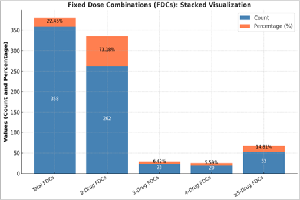Analysis of Drug Utilization Patterns and Prescribing Practices in the Department of Obstetrics and Gynecology at a Tertiary Care Facility in North India: A Cross-Sectional Observational Study
Authors
##plugins.themes.bootstrap3.article.main##
Abstract
Background: Rational use of medicines (RUM) is crucial for optimal patient care and efficient utilization of healthcare resources. In obstetrics and gynecology, inappropriate prescribing practices can lead to significant health hazards and resources wastage. This study analyses drug utilization patterns and prescribing practices in a tertiary care hospital’s obstetrics and gynecology department to evaluate adherence to RUM principles. Methods: A prospective, cross-sectional observational study was conducted at the Department of Obstetrics and Gynecology in collaboration with the Department of Pharmacology at Sharda Medical School of Research and associated Sharda Hospital, North India, over six months. The prescriptions were analyzed by the WHO/International Network for Rational Use of Drugs (INRUD) core drug use prescribing indicators and complementary indices. Results: The study analyzed 609 prescriptions, comprising 1,595 drugs. The average number of drugs per prescription was 2.62. Generic prescribing was low (22.4%), and antibiotic encounters were high (36.5%), highlighting the need for antimicrobial stewardship. Injectable prescriptions accounted for 9.85% of encounters. Only 42% of drugs were from the National List of Essential Medicines (NLEM). Polypharmacy (>4 drugs) was observed in 11% of prescriptions, and 22.4% of prescriptions included fixed-dose combinations (FDCs). Conclusion: The findings emphasize the need for interventions to enhance generic prescribing, rational antimicrobial use, and adherence to essential drug lists. Continuous prescription audits and educational programs are recommended to promote RUM in obstetrics and gynecology.
##plugins.themes.bootstrap3.article.details##
Copyright (c) 2025 Dr. Geeta Katheit Rai, Dr. Deepali Raina, Dr. Niket Rai, Dr. Nidhi Maheshwari

This work is licensed under a Creative Commons Attribution 4.0 International License.
Creative Commons License All articles published in Annals of Medicine and Medical Sciences are licensed under a Creative Commons Attribution 4.0 International License.
Dr. Deepali Raina, Assistant Professor, Department of OBGY, School of Medical Science and Research, Sharda University, Greater Noida 201310, India.
Assistant Professor, Department of OBGY, School of Medical Science and Research, Sharda University, Greater Noida 201310, India.
Dr. Niket Rai, Professor and Head, Department of Pharmacology, L. N., Medical College & J. K. Hospital, Bhopal, MP 462046, India.
Professor and Head, Department of Pharmacology, L. N., Medical College & J. K. Hospital, Bhopal, MP 462046, India.
Dr. Nidhi Maheshwari, Assistant Professor, Department of Pharmacology, School of Medical Science and Research, Sharda University, Greater Noida 201310, India.
Assistant Professor, Department of Pharmacology, School of Medical Science and Research, Sharda University, Greater Noida 201310, India.
[1] WHO Policy Perspectives on Medicines-Promoting rational use of medicines: core components WHO Policy Perspectives on Medicines [Internet]. 2002. Available from: https://iris.who.int/bitstream/handle/10665/67438/WHO_EDM_2002.3.pdf
[2] Milani B, Scholten W. THE WORLD MEDICINES SITUATION 2011 ACCESS TO CONTROLLED MEDICINES. 2011.
[3] Hailesilase GG, Welegebrial BG, Weres MG, Gebrewahd SA. WHO/INRUD prescribing indicators with a focus on antibiotics utilization patterns at outpatient department of Adigrat general hospital, Tigrai, Ethiopia: a retrospective cross-sectional study. Antimicrob Resist Infect Control. 2024 Dec 1;13(1):133.
[4] Mudenda S, Chilimboyi R, Matafwali SK, Daka V, Mfune RL, Kemgne LAM, et al. Hospital prescribing patterns of antibiotics in Zambia using the WHO prescribing indicators post-COVID-19 pandemic: findings and implications. JAC-Antimicrobial Resist. 2024 Feb 1;6(1).
[5] Ofori-Asenso R, Brhlikova P, Pollock AM. Prescribing indicators at primary health care centers within the WHO African region: A systematic analysis (1995-2015). BMC Public Health. 2016 Aug 22;16(1).
[6] WHO report [Internet]. Vol. 93. 1993 [cited 2025 Feb 22]. p. 12 How to Investigate Drug Use in Health Facilities: Selected Drug Use Indicators. WHO/DAP/93.1. Geneva: World Health Organization; 1993. Available from: https://www.who.int/publications/i/item/who-dap-93.1
[7] Hutubessy RCW, Baltussen R, Tan Torres-Edejer T, Evans DB. WHO-CHOICE: Guide to Cost-Effectiveness Analyis. Heal Syst Perform Assess debates, methods empiricism Geneva WHO Ed [Internet]. 2003;823–835. Available from: http://books.google.com/books?hl=en&lr=&id=_HloWI6HXbcC&oi=fnd&pg=PR9&dq=edejer+baltussen&ots=hgTnNiuW9x&sig=ffrEjZ6TyLp1EM1y39gYfpVBno8
[8] Haque M. Generic medicine and prescribing: A quick assessment. Adv Hum Biol. 2017;7(3):101.
[9] Gupta V, Sharma VK. Syndromic management of sexually transmitted infections: A critical appraisal and the road ahead. Natl Med J India [Internet]. 2019;32(3):147–52. Available from: https://nmji.in/view-pdf/?article=a9910d08e22015c840d6c965395b7617RC3F77lPxuc=
[10] U.S. Department of Health & Human Servis. Sexually Transmitted Infections Treatment Guidelines - Pelvic Inflammatory Disease (PID). Centers Disaese Control Prev. 2023;(1157):1–7.
[11] Dagli RJ, Sharma A. Polypharmacy: A Global Risk Factor for Elderly People. 2014;6(6):6–7.
[12] WHO, Report HT. A GLOSSARY OF TERMS FOR COMMUNITY HEALTH CARE AND SERVICES FOR OLDER PERSONS. Vol. 5. 2004. p. 45.
[13] MS B, TR B, SN G, Sonali D, SM D. Drug utilization study of gynecology OPD: In a tertiary care hospital. Int J Med Res Heal Sci. 2013;2(2):156.
[14] Bhagavathula AS, Vidyasagar K, Chhabra M, Rashid M, Sharma R, Bandari DK, et al. Prevalence of Polypharmacy, Hyperpolypharmacy and Potentially Inappropriate Medication Use in Older Adults in India: A Systematic Review and Meta-Analysis. Front Pharmacol. 2021;12(May).
[15] Siddiqui R, Shende T, Mahajan H. Evaluation of prescribing pattern of fixed-dose combinations in obstetrics and gynecology department of a tertiary care hospital of central India. Natl J Physiol Pharm Pharmacol. 2024;14(5):1.

